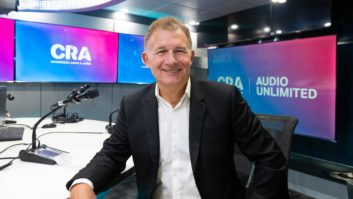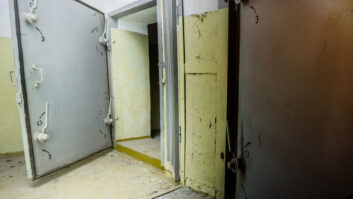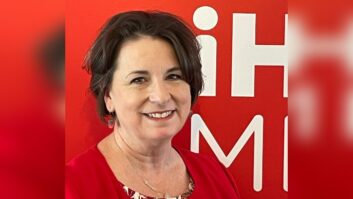
The Geluidshuis voice booth is used for the recording of
“Café Cuba.” Photo by M. Maes
ANTWERP, Belgium — Seventeen years after VRT radio aired the last sequel of “Het Koekoeksnest” (“The Cuckoo’s Nest”), the Dutch-language public broadcaster resumed the path of radio drama with “Café Cuba” on Radio 2.
“Café Cuba,” a fictional story of friendship, love and art during World War I, ran from Sept. 8 to Nov. 11, Armistice Day. VRT called on Antwerp-based production house Het Geluidshuis to handle radio production of the show, which was part of the Gone West project in remembrance of the war.
ORIGINAL FORMAT
Het Geluidshuis’ Director Leen Renders and Engineer Olivier Marga took on the casting, recording, editing and production of “Café Cuba.” The production house initially launched as a traditional music recording studio and entered the radio landscape as production unit for radio commercials in Dutch and French. “We have organically grown into recording for broadcast,” said Leen Renders.
Today, Het Geluidshuis operates two major recording studios, a studio for editing and post-production as well as a smaller music recording studio and one voice booth for pre-production. Three directors and three engineers make up the production team, headed by Founder and Managing Director Koen Brandt.
“My job is to edit the text content and adapt it to for audio and speech reproduction, edit the dialogues and coach the actors during the recording,” said Renders. “Emotions, tone, keeping pace with the overall story and finding the right sounds, maintaining the attention span are crucial here.”

Actor Herbert Flack is the narrator of “Café Cuba.”
Photo courtesy VRT Radio 2
In the studio, Marga uses a Neumann U 87 studio mic for vocal recordings. “Most people don’t realize that all of the spoken word was recorded in our voice booths — but consistent sound quality, and a very ‘dry’ recording facilitates editing, matching the takes and post-production,” he said. Sound effects are mixed in afterwards, he explained.
For the recording of sound effects, Marga relies on the company’s comprehensive audio archives and sound libraries. For outside and on-location recording, he makes use of Sennheiser ME66 shotgun mic.
“‘Café Cuba’’s soundtrack is a combination of library sounds, and self-produced effects,” said Renders. “This sometimes required being quite creative with props — like in the case where a violin is being smashed to pieces. ‘Café Cuba’ is a realistic story with background noises such as bombs and fighting. The music score [session musicians and digital instruments] was recorded by Koen Brandt.”

Director Leen Renders in the production studio.
Photo by M. Maes
LABOR-INTENSIVE
Marga and Renders say that, compared to the VRT’s last big radio drama, the “Koekoeksnest,” which was recorded live in a studio and aired for seven years, things have evolved. “Café Cuba” is fully prerecorded and totals up to approximately three hours of content for 46 sequels. “‘Café Cuba’’s storyboard has more layers, is more complex and much more faster,” said Renders.
Het Geluidshuis recorded all story content into a Pro Tools 11.2 digital audio workstation and with Focusrite Redpreamps. The production house then bounced the “Café Cuba” digital audio files in WAV format to VRT’s main server for broadcast. “Contrary to standard radio commercials, where loudness is key and a flat mix essential, ‘Café Cuba’ has a more dynamic mix,” said Marga. “VRT then compresses the final result for broadcast.”
“Café Cuba” required over six months of work, quite labor-intensive, with a considerable production cost as a result. “We really hope that radio drama returns to radio again,” said Renders. “The idea that people only listen for three minutes, that radio is reduced to wallpaper, is definitely untrue. VRT’s Radio 1 is a good example of how radio should work. With ‘Café Cuba’ on Radio 2, we know that people will sit and listen.”
“‘Café Cuba’ was the result of a perfect collaboration between Radio 2, Het Geluidshuis and Gone West,” said Jan Knudde, VRT Radio 2 station manager. “At Radio 2 we emphasize the regional element throughout our programs, and this fall saw plenty of Great War cultural remembrance projects, which included ‘Café Cuba.’”

Olivier Marga works in the control room of the
main recording studio. Photo by M. Maes Knudde adds that “Café Cuba” fits Radio 2’s tradition to introduce original productions in its programming. “But at present, we don’t have plans for new radio drama,” he said. “The main reason is budgetary. It’s a demanding format, substantially more expensive than other radio content. But with close to 600,000 people tuning in every day, we surely have an audience for radio drama.”
“Café Cuba,” based on true stories as displayed at the In Flanders Fields Museum, was broadcast as a part of the Avondpost (evening post) program on all of VRT Radio 2’s regional channels. The five-minute sequels are available at www.radio2.be and www.cafecuba.be.
Marc Maes reports on the industry for Radio World from Antwerp, Belgium.












